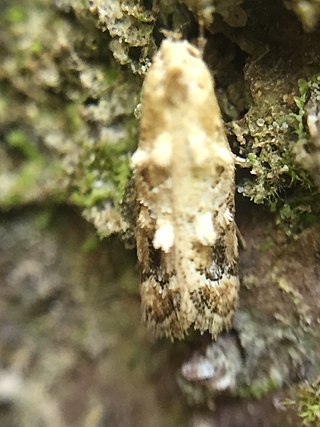Copromorpha nesographa is a moth in the Copromorphidae family. It is found on New Ireland.
Hypatima dissidens is a species of moth in the family Gelechiidae. It was described by Edward Meyrick in 1913. It is found in Mpumalanga, South Africa.
Hypatima euplecta is a species of moth in the family Gelechiidae. It was described by Edward Meyrick in 1904. It is found in Australia, where it has been recorded from Queensland, New South Wales, Victoria and South Australia.
Ardozyga deltodes is a species of moth in the family Gelechiidae. It was described by Oswald Bertram Lower in 1896. It is found in Australia, where it has been recorded from Victoria and New South Wales.
Anacampsis petrographa is a moth of the family Gelechiidae. It was described by Edward Meyrick in 1922. It is found in Brazil (Para).
Antaeotricha generatrix is a moth of the family Depressariidae. It is found in Brazil.
Stenoma recondita is a species of moth of the family Depressariidae. It is found in Guyana.
Chlamydastis synedra is a moth of the family Depressariidae. It is found in Paraguay.
Antaeotricha basalis is a species of moth of the family Depressariidae. It is found in Argentina.
Stenoma hopfferi is a moth of the family Depressariidae. It is found in Brazil (Pará) and the Guianas.
Stenoma thoristes is a moth of the family Depressariidae. It is found in French Guiana.
Stenoma himerodes is a moth of the family Depressariidae. It is found in French Guiana.
Antaeotricha substricta is a species of moth of the family Depressariidae. It is found in French Guiana.
Exaeretia hermophila is a moth in the family Depressariidae. It was described by Edward Meyrick in 1922. It is found in Guinea.
Antaeotricha nimbata is a moth in the family Depressariidae. It was described by Edward Meyrick in 1925. It is found in Peru.
Antaeotricha orthriopa is a species of moth in the family Depressariidae. It was described by Edward Meyrick in 1925. It is found in Brazil.
Antaeotricha euthrinca is a species of moth in the family Depressariidae. It was described by Edward Meyrick in 1915. It is found in Colombia.
Imma eriospila is a species of moth in the family Immidae. It was described by Edward Meyrick in 1922. It is found in Pará, Brazil.

Opsitycha squalidella is a moth of the family Oecophoridae. It was described by Edward Meyrick in 1884. This species is native to Australia and is likely adventive to New Zealand.

Trachypepla aspidephora is a species of moth in the family Oecophoridae. It is endemic to New Zealand and has been observed in the North and South Islands. Adults are on the wing from November to March and are attracted to light. The moths can be found resting on tree trunks where their colouration imitates lichens.

